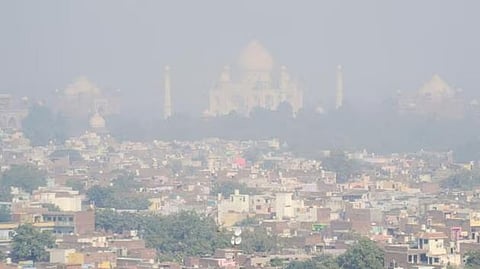Agra In Pollution Cauldron, Monumental Failure Of The TTZ
Agra, November 22 (TNA) More than a quarter century has passed after the 1994 intervention of the Supreme Court to make Agra safe for the Taj Mahal and other heritage assets, but the results are not showing. The Taj trapezium zone authority constituted by an Act of the parliament, has dismally failed to control pollution and improve quality of life.
Local environmentalists have demanded that the mandarins in the TTZ Authority revisit the recommendations of the Dr S Vardarajan Committee, and carry out a social audit of all air, water, and noise pollution abatement projects in the TTZ, in collaboration with the stakeholders. This exercise is the need of the hour to initiate course correction measures.
The green activists have drawn attention to the increasing air pollution in the Taj city due to traffic congestion, poor quality of roads, encroachments, lack of coordination among various agencies, and a generally low level of traffic sense among the locals.
"This is the right time to transition from traffic to mobility management. Our focus has to be human beings and not machines or vehicles," says environmentalist Dr Devashish Bhattacharya. Studies by several institutions have indicated that Private vehicle usage in Agra will increase more than in the megacities.
While it is definitely an advantage that more people presently use buses and non-motorised vehicles to commute or walk, thus helping to manage air pollution and urban mobility, unfortunately, this 'walking and cycling city' is now steadily shifting towards cars and two-wheelers as public transport remains inadequate and unequal to the demand pressure.
All recent studies suggest that there is a very high level of killer particles in the ambient air: Firozabad, Agra, and Mathura have three times the highest critical level of PM10. NO2 is showing a rising trend; SPM and RSPM levels are rising unchecked. The number of cars and two-wheelers has crossed the number of walk and cycle trips. The city is beginning to cross the tipping point.
Agra is paying a very high price due to traffic congestion on almost all roads. Traffic jams lead to fuel wastage, more pollution, and serious economic losses. A normal commuting time has increased significantly during peak hours. On many arterial roads, the traffic volume has exceeded the designed capacity and the service level of the roads.
Building more roads is not the answer. Look at Delhi. It has more than 66 fly overs, and an extensive road network but peak hour traffic movement has come down to below 15 km per hour. Cars and two-wheelers in Delhi occupy 90 per cent of road space but meet less than 20 per cent of the travel demand.
So far the walk and cycle share of Agra is high at 53 per cent. Kanpur's is 64 and Varanasi's is 56 percent. To increase this, there is a need for policy support.
Private vehicle usage share in Agra of total motorised transport is relatively higher compared to metros. Agra's private vehicle share is 48 per cent, Varanasi’s 44 per cent, and Kanpur's is 37 per cent. At the national level, more than 70 per cent of the investments have been made in car-centric infrastructure, including flyovers and road widening, while investments in the pedestrian and bicycle segments are not of the desired scale.
A very high share of road length comes under on-street parking pressure, close to 50 per cent. This causes congestion and pollution. New car registration creates demand for land equal to 14 fields in Agra, 42 in Lucknow, and 310 in Delhi. Where's the land? In UP, Varanasi and Kanpur, with comparatively much fewer vehicles, have congestion levels close to that of Delhi, Kanpur, Varanasi, and Agra have lower walkability index ratings compared to Chandigarh which has the highest value on this index Agra like Patna, Varanasi has higher non-motorised traffic on roads, and more slow-moving vehicles.
Traffic volume in Agra has crossed the designed capacity of roads which are heavily encroached upon and the surface quality is also poor. Soft options have all been exhausted. It’s time for drastic measures. Reducing personal vehicle usage, upgrading public transport, walking and cycling, and leap-frogging vehicle technology are the key options left for us.
Therefore, the government should plan for people and not vehicles. Design roads for public transport, cycling, and walking, and not just for private motorised vehicles. This is the option for the city to cut killer pollution, crippling congestion, expensive oil-guzzling, and global warming impacts of vehicles. Short distances should usually be covered on foot or using bicycles, even battery-operated vehicles are a better option.
Schools must be encouraged to deploy a fleet of buses to haul students from their homes. This can be done by cutting road taxes and various other levies on buses and other forms of public transport. At the moment in most Indian states, buses pay more or the same as private cars. This policy needs to change in favour of buses.
The state government has to be pressured to cut down taxes on cycles and spare parts of cycles plus accessories to encourage people to purchase them.

